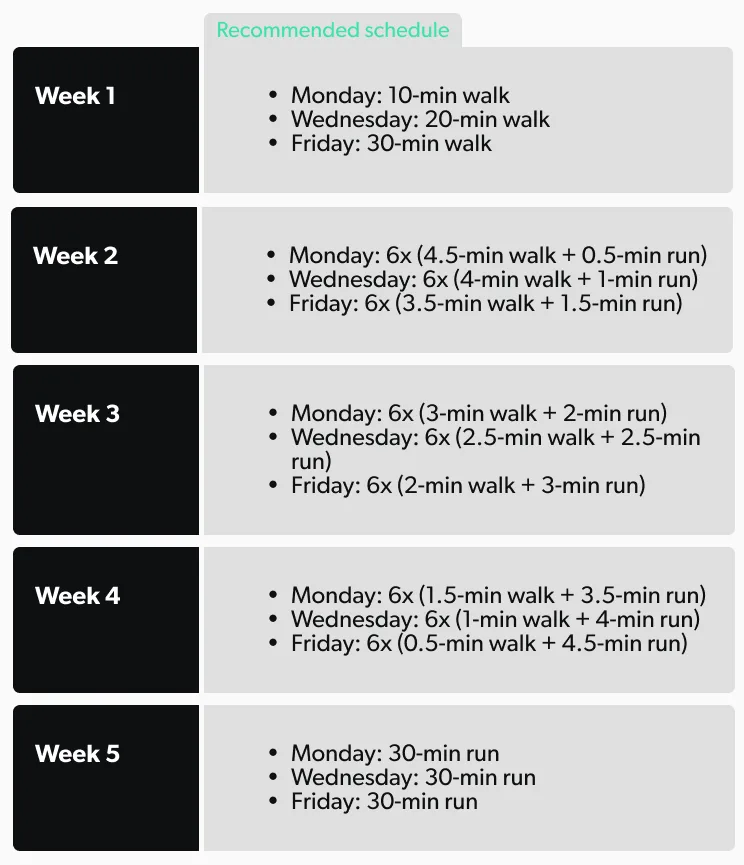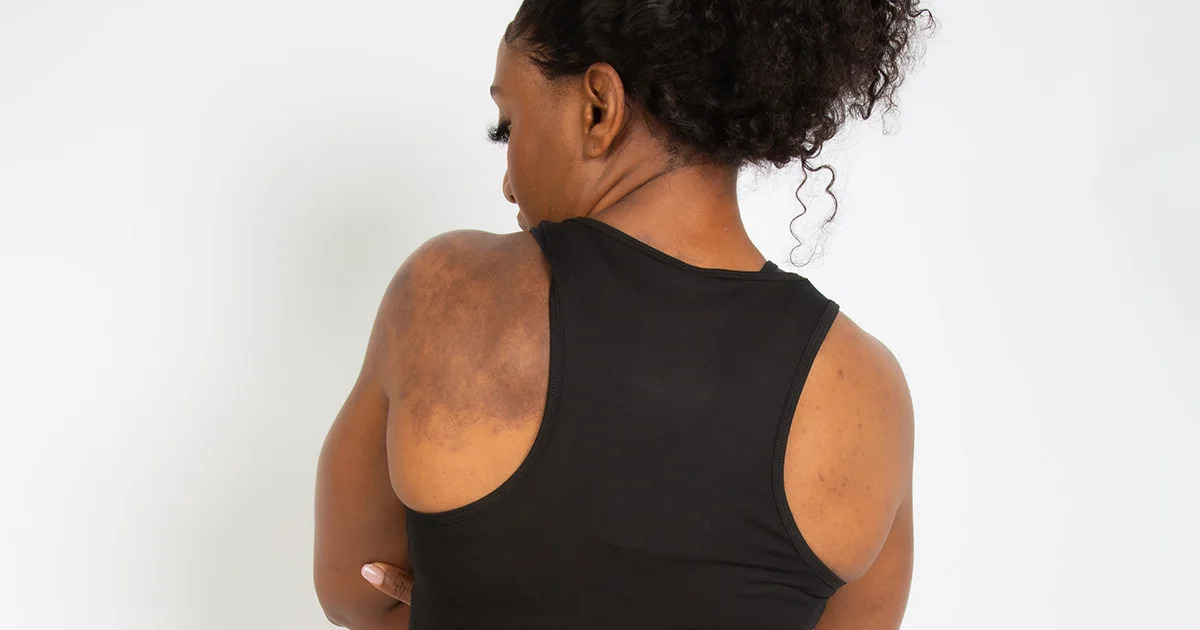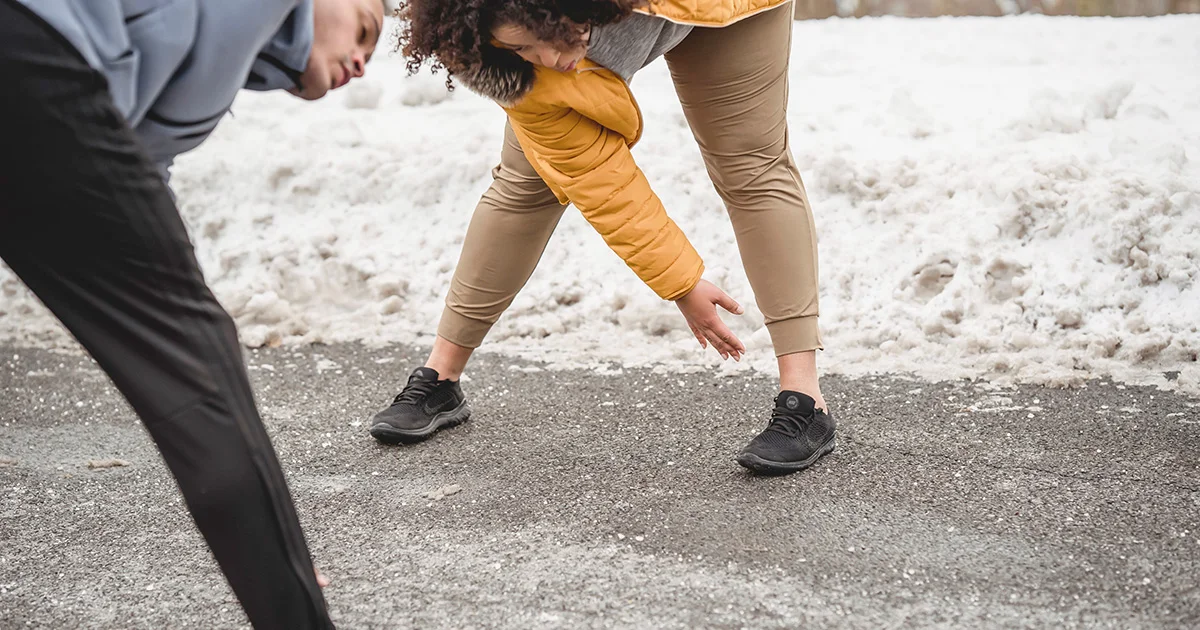Here's what we'll cover
Here's what we'll cover
If you’re looking to get more physical activity, running is a popular option for a reason. It requires little equipment, is easily accessible, and is a very time-efficient form of exercise.
Running is a natural and straightforward process, but there are some best practices to learn when you get started. Here are 10 tips for how to start running when you’re a beginner.
Why should you start running?
The World Health Organization and the U.S. government have released evidence-based Physical Activity Guidelines, recommending at least 150 minutes of moderate-intensity or 75 minutes of vigorous-intensity aerobic activity per week, or an equivalent combination of both (Lee, 2014).
Beginner runners don’t have to go out and run sprints or half-marathons to reap the benefits of regular exercise. Running, even 5–10 minutes per day and at slow speeds less than 6 mph, can reduce your risk of heart disease and death from all causes (Lee, 2014).
Physically inactive adults who began a running program have shown improvements in their (Hespanhol Junior, 2015):
Body mass index (BMI)
Body fat percentage
Resting heart rate
Running isn’t just good for your body; it can help your mental health, too. Poor mental health contributes to poor overall health outcomes. Scientific evidence shows that physical activity, including running, can improve mental health conditions, particularly depression and anxiety (Oswald, 2020).
How to start running as a beginner
The key to starting a running program as a beginner is to do it slowly. Don’t be afraid to start with a run-walk plan and build endurance over some time. Once you can walk for 30 minutes, three times weekly, and without pain, begin to add in a half-minute of running (Johnston, 2003).
Here’s a sample walk/run plan for a beginner. Over five weeks, you’ll gradually increase the amount of time you are running until you can eventually run for 30-minute sessions (Johnston, 2003).

Running tips for beginners
Wondering how to start running? You don’t have to spend money on a fancy running coach or electronic trackers as a new runner. Just review these tips for getting started before your first run.
1. Get medical clearance
If you’ve been inactive for a while or you’re just getting back into exercise after an illness or injury, make sure to check with a healthcare provider before starting a new exercise program (Niemiro, 2021).
You can usually still exercise even if you have certain health conditions, such as obesity, heart, lung, or orthopedic issues. However, you might need to make some adjustments to your running program to make it safe for your specific situation. A healthcare provider can help you know what changes to make (Niemiro, 2021).
2. Get motivated
It's easy to start a new exercise program, but it can be difficult to maintain it over the long run. Some tips for getting and staying motivated with your new running routine include:
Have a training plan to follow.
Set and track your goals.
Make a new playlist of music or podcasts.
Find an exercise buddy.
Join a run club.
Plan some fun rewards for meeting your goals.
3. Get a good pair of running shoes
A good pair of shoes is a must for any new runner. Over the last 50 years, recommendations for running shoes have run the gamut from minimalist to highly cushioned, then back and forth again (Sun, 2020).
Research into running shoe construction shows that shoes with a softer, thicker midsole can reduce impact forces and provide better cushioning. This could be helpful if you are just getting started with running (Sun, 2020).
Minimalist running shoes can improve your running performance, but they can also put more stress on your feet than conventional shoes. If you want to try minimalist shoes, a progressive training period is recommended to reduce the risk of injuring yourself (Sun, 2020).
4. Wear the right gear
You don’t need any fancy running gear to get started. Comfort is the most important quality for running clothes, especially when you’re just getting started.
Stick with lightweight clothing in sweat-wicking materials. Look for polyester, nylon, or wool, which all absorb very little water, unlike clothes made of cotton. Dress in layers, especially in the winter, so that you can remove articles as you warm-up.
If you have breasts, a highly supportive sports bra is necessary to prevent discomfort while running.
5. Warm up
Now it's time to get moving. Be sure to loosen up your leg muscles before you start. Warm-up and cool-down exercises can help you avoid stiff muscles and soreness after exercises. It can also help with injury prevention.
Some common running warm-up exercises include:
Dynamic stretching (like lunges or lifting your knee to your chest)
Brisk walking
6. Stay safe
Stay safe during your new running routine. Avoid routes with heavy traffic or a lack of sidewalks. If you do run on the streets, make sure you wear high-visibility clothing and stay aware of your surroundings. Try not to plan your runs during rush hour or at dawn or dusk when visibility is poorer.
If you’re going to listen to music while you run, make sure it doesn’t prevent you from hearing an approaching person or vehicle. Keep one earbud out or ditch them altogether and just use the speaker on your phone.
7. Practice your form
Practicing your running form can help you conserve energy, run faster and longer, and reduce your risk of injury. Keep your head up, and don’t hunch your shoulders. Let your arms swing naturally, with your elbows bent at a 90-degree angle. Your hands should stay relaxed.
There are three types of foot strike patterns that human runners can use. These are categorized by the part of the foot that first contacts the ground when you run. These patterns are rearfoot, midfoot, and forefoot (Hamill, 2017).
There are many different opinions about which foot strike pattern is best. However, researchers haven’t found any significant differences in the rates of injuries between runners with different patterns. They’ve concluded there is likely no obvious benefit to changing your foot strike pattern, especially for recreational runners (Hamill, 2017). Your best bet is to stick with what feels most comfortable to you.
8. Stay hydrated
Whether it’s hot or cold outside, you will lose water through sweat when you run. Pay attention to your thirst levels while running and drink before, during, and after your run.
If you’re running longer distances, some of your hydration should include a sports drink or water with added electrolytes. This will help your body replace the carbohydrates and electrolytes that it loses through sweating.
9. Give your body proper nutrition
All runners need the right fuel for their workouts. This looks different for each person depending on their (Kerksick, 2017):
Age
Sex
Fitness level
Dietary status
Training intensity
Program design
Time until next training or competition
In general, you’re going to want to ensure that you’re consuming enough calories, carbohydrates, and protein for optimal performance. For long runs, this might include using sports drinks or gels during your run to make sure you have enough energy to make it to the finish (Kerksick, 2017).
Ingesting carbohydrates in the four to six hours post-run can help replenish spent fuel stores on your body. Adding additional protein can help minimize muscle damage and accelerate your recovery (Kerksick, 2017).
10. Monitor your progress
A running journal can help you keep track of the ups and downs during your running experience. It's a good motivator for the days when you just don’t feel like running. You can look back at all the hard work you have accomplished and the progress that you’ve made.
DISCLAIMER
If you have any medical questions or concerns, please talk to your healthcare provider. The articles on Health Guide are underpinned by peer-reviewed research and information drawn from medical societies and governmental agencies. However, they are not a substitute for professional medical advice, diagnosis, or treatment.
Hamill, J. & Gruber, A. H. (2017). Is changing footstrike pattern beneficial to runners? Journal of Sport and Health Science, 6 (2), 146-153. doi: 10.1016/j.jshs.2017.02.004. Retrieved from https://www.sciencedirect.com/science/article/pii/S2095254617300285?via%3Dihub
Hespanhol Junior, L. C., Pillay, J. D., van Mechelen, W., & Verhagen, E. (2015). Meta-analyses of the effects of habitual running on indices of health in physically inactive adults. Sports Medicine, 45, 1455–1468. doi: 10.1007/s40279-015-0359-y. Retrieved from https://link.springer.com/article/10.1007/s40279-015-0359-y
Johnston, C. A., Taunton, J. E., Lloyd-Smith, D. R., & McKenzie, D. C. (2003). Preventing running injuries. Practical approach for family doctors. Canadian Family Physician Medecin De Famille Canadien, 49, 1101–1109. Retrieved from https://www.ncbi.nlm.nih.gov/pmc/articles/PMC2214294/
Kerksick, C., Arent, S., Schoenfeld, B., Stout, J., Campbell, B., Wilborn, C., et al. (2017). International society of sports nutrition position stand: nutrient timing. Journal of the International Society of Sports Nutrition, 14 (33). doi: 10.1186/s12970-017-0189-4. Retrieved from https://jissn.biomedcentral.com/articles/10.1186/s12970-017-0189-4#article-info
Lee, D. C., Pate, R. R., Lavie, C. J., Sui, X., Church, T. S., & Blair, S. N. (2014). Leisure-time running reduces all-cause and cardiovascular mortality risk. Journal of the American College of Cardiology, 64 (5), 472–481. doi: 10.1016/j.jacc.2014.04.058. Retrieved https://www.ncbi.nlm.nih.gov/pmc/articles/PMC4131752/
Niemiro, G. M., Rewane, A., & Algotar, A. M. (2021). Exercise and fitness effect on obesity. [Updated Jun 8, 2021]. In: StatPearls [Internet]. Retrieved on Oct. 6, 2021 from https://www.ncbi.nlm.nih.gov/books/NBK539893/
Oswald, F., Campbell, J., Williamson, C., Richards, J., & Kelly, P. (2020). A scoping review of the relationship between running and mental health. International Journal Of Environmental Research and Public Health, 17 (21), 8059. doi: 10.3390/ijerph17218059. Retrieved from https://www.ncbi.nlm.nih.gov/pmc/articles/PMC7663387/
Sun, X., Lam, W. K., Zhang, X., Wang, J., & Fu, W. (2020). Systematic review of the role of footwear constructions in running biomechanics: implications for running-related injury and performance. Journal of Sports Science & Medicine, 19 (1), 20–37. Retrieved from https://www.ncbi.nlm.nih.gov/pmc/articles/PMC7039038/












